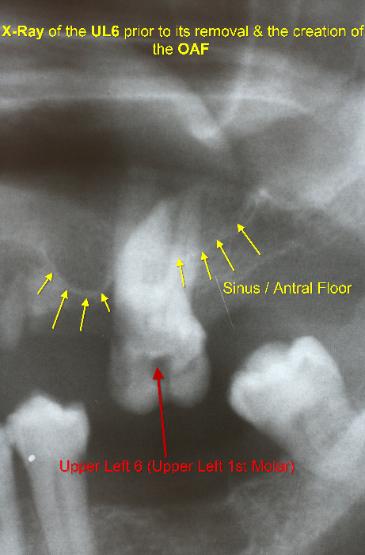What is Jaw Joint Arthrocentesis?
TMJ / Jaw Joint Arthrocentesis (the washing out
of the jaw joint space) is a procedure during
which the jaw joint is washed out with sterile
saline ± anti-inflammatory steroids, long-acting
local anæsthetics, painkillers or collagen
components.
TMJ / Jaw Joint Arthrocentesis (the washing out
of the jaw joint space) is a procedure during
which the jaw joint is washed out with sterile
saline ± anti-inflammatory steroids, long-acting
local anæsthetics, painkillers or collagen
components.
TMJ / Jaw Joint Arthrocentesis reduces jaw joint pain,
improves jaw joint function and reduces jaw joint clicking.
TMJ / Jaw Joint Arthrocentesis of the (upper) joint space
reduces jaw joint pain by:
The majority of restricted opening is secondary to upper
joint space problems, particularly ‘anchored disc’
phenomenon, where arthrocentesis is particularly beneficial.
When is Jaw Joint Arthrocentesis used?
Indications for arthrocentesis are:
What does the treatment involve?
TMJ / Jaw Joint Arthrocentesis usually takes place under aGeneral Anæsthetic - this means you will be asleep for the
entire procedure. Whilst you are asleep, two small
needles will be inserted into the TMJ / Jaw Joint. One of
these needles allows sterile saline to be pumped into the
joint under pressure whilst the other needle allows the
saline to drain out of the joint.
improves jaw joint function and reduces jaw joint clicking.
TMJ / Jaw Joint Arthrocentesis of the (upper) joint space
reduces jaw joint pain by:
- diluting / flushing out the inflammatory chemicals from the jaw joint
- increasing mandibular (lower jaw) movements by removing intra-articular adhesions (scarring within the joint space)
- eliminating the negative pressure within the jaw joint
- recovering disc and fossa space and improving disc mobility (return the disc of cartilage to its normal position within the joint) which reduces the mechanical obstruction caused by the anterior (forward) position of the disc.
The majority of restricted opening is secondary to upper
joint space problems, particularly ‘anchored disc’
phenomenon, where arthrocentesis is particularly beneficial.
When is Jaw Joint Arthrocentesis used?
Indications for arthrocentesis are:
- dislocation of the articular disc ± reduction
- limitations of mouth opening originating in the jaw joint
- joint pain and other internal derangements of the TMJ.
TMJ / Jaw Joint Arthrocentesis usually takes place under aGeneral Anæsthetic - this means you will be asleep for the
entire procedure. Whilst you are asleep, two small
needles will be inserted into the TMJ / Jaw Joint. One of
these needles allows sterile saline to be pumped into the
joint under pressure whilst the other needle allows the
saline to drain out of the joint.
What are the possible complications?
Complications after puncture of the TMJ depend on the
anatomy of the joint and its relations.
Possible complications of TMJ / Jaw Joint Arthrocentesis
also depend on the technique used. The complication rate
following TMJ / Jaw Joint Arthrocentesis is given as
between 2 - 10%.
Complications usually present in the immediate post-
operative phase and are mostly associated with fluid
collection and vascular injury.
Complications after puncture of the TMJ depend on the
anatomy of the joint and its relations.
Possible complications of TMJ / Jaw Joint Arthrocentesis
also depend on the technique used. The complication rate
following TMJ / Jaw Joint Arthrocentesis is given as
between 2 - 10%.
Complications usually present in the immediate post-
operative phase and are mostly associated with fluid
collection and vascular injury.
- Facial Muscle Weakness (< 1.0%) (temporary / permanent) resulting from injury to the Facial Nerve whilst gaining access to the jaw joint space. The most common problem resulting from this, is the inability to wrinkle the brow, raise the eyebrow or gain tight closure of the eyelids.
- Numbness (< 2.5%) (temporary / permanent) of certain areas of skin in the region of the jaw joint and sometimes in more remote areas of the face or scalp.
- Bleeding within the jaw joint which cannot be adequately controlled and could require immediate intervention by open joint surgery.
- Ear problems (< 9.0%), including inflammation of the ear canal, middle / inner ear infections, vertigo, perforation of the ear-drum and temporary / permanent hearing loss.
- Instrument Separation (that is, the needle breaks off within the joint space) which may require open joint surgery.
- Facial Scarring from the entry injection.
- Damage to the jaw joint surface during the arthrocentesis procedure, usually of a reversible nature but which could permanently affect joint function.
- Unsuccessful entry into the jaw joint or inability to accomplish the desired procedure because of limited motion of the jaw joint / scarring.
- Worsening of present TMJ symptoms which may require repeat arthrocentesis, arthroscopy or open joint surgery.
- Changes in the bite after arthrocentesis which may affect chewing functions. In addition, there may be temporary / permanent limited mouth opening.
- Post-operative infection requiring additional treatment.
- Adverse / Allergic reactions to any of the medications used in the procedure.
- Pre-Auricular Hæmatoma.
- Extravasation of fluid from the jaw joint into the surrounding tissues.














